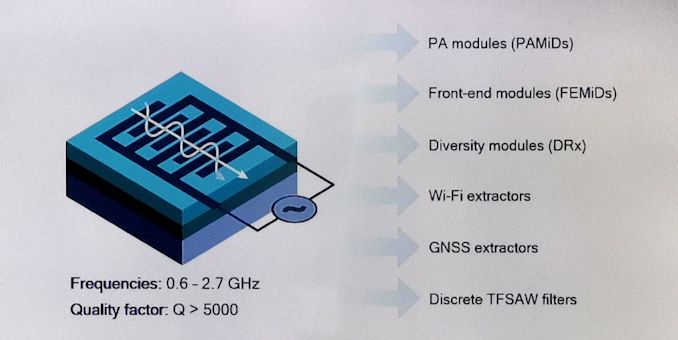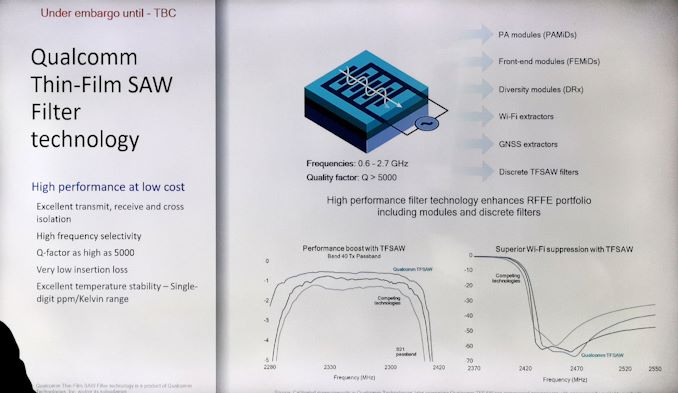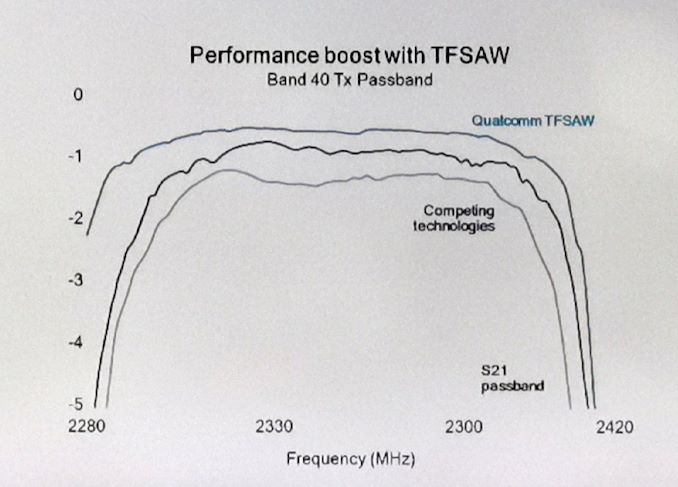Qualcomm’s March on Connection Quality: New RF Filters with up to 0.8 dB Better Performance
by Dr. Ian Cutress on February 18, 2020 7:30 AM EST- Posted in
- Smartphones
- Qualcomm
- Wi-Fi
- RF
- Filter

One of the key components to any wireless system is the ability to detect the required frequency and ensure a clean signal with a stable connection. In order to do this, especially with Radio Frequency connections such as those in cell phones, a variety of filters are needed for specific frequency selection. Today Qualcomm is announcing that it has made a new breakthrough in its RF filter design through a novel thin film technology.
The new technology allows Qualcomm to produce filters from 0.6 GHz to 2.7 GHz (i.e. LTE) with better efficiency / lower power per bit than in previous generations. Qualcomm states a quality factor of over 5000, which it rates as market leading. With the new filters, Qualcomm is claiming a 0.8-1.0 dB better signal detection clarity than competing technologies. The example Qualcomm gives is the signal performance on Band 40:
Here QC is showing the signal loss for Band 40 transmission between 2290 and 2400 MHz – while the standard requires around 1.5 dB loss, competing technologies can achieve up to 1-1.2 dB loss, while Qualcomm can achieve under 1 dB loss across the whole range, with gains up to 0.8 dB in places, especially at the edges where signal can be at its weakest.
It’s worth noting that the x-axis in this graph isn’t linear – it appears the two middle values have been swapped for some reason.
With the new thin film technology, Qualcomm also claims that it can provide Wi-Fi isolation filters and suppression than the competition.
We’re not expecting Qualcomm to announce when it is using the new technology in its next generation products – to be honest I’m even surprised Qualcomm is making this announcement given the context of what would be Mobile World Congress. Technically there is another event this week in San Francisco, the International Solid State Conference, where this is the sort of thing that would be presented, however I can’t find a paper set to be presented at that conference that includes this. If Qualcomm are ready to commercialize its new thin film technology, which may explain this.












15 Comments
View All Comments
FreckledTrout - Tuesday, February 18, 2020 - link
It used to matter. I think at some point call quality and data speed in less than ideal areas will become more compelling again. Especially as smart phones start to become more of commodity items like the dumb phones where in the past.NICOXIS - Tuesday, February 18, 2020 - link
I'd rather have this than 5GYojimbo - Tuesday, February 18, 2020 - link
It's well known that if you ask them, people would rather have some slight improvement in what they already know than a true innovation because people can definitively see how the improvement can help them but they cannot see the possibilities opened up by the substantial change.reggjoo@gmail.com - Tuesday, February 18, 2020 - link
So this advancement will give better signal quality, and lower latency on the edges of coverage? Better signal quality, further out of range, is a good thing, no matter who makes the modem. Apple bought intels division, for a reason, so they won’t have to run to Qualcomm. The problem, though, is intel gave up, because they couldn’t compete with Qualcomm’s solutions. Apple may have a bought a brick, just like google did, buying htc’s phone dev team. Nothing really great is coming from Google’s acquisition, and it shows in sales of current pixels. Apple will use Qualcomm’s modems, til they can catch up to Qualcomm, in performance from the division they bought from intel.Christian Fitchett - Wednesday, February 19, 2020 - link
Really cool article!